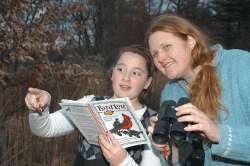This is a guest blog post from Jennifer Fee, K-12 Programs Manager, at Cornell Lab of Ornithology.

Calling all educators: if you’ve participated in citizen science projects, we need your ideas for a book we are writing! Citizen science is different from the traditional ‘cookbook’ approach to science education, and we’d like to know how you and your students take part so that we can inspire other teachers to give citizen science a try!
Citizen science projects can bring science to life, motivating students with their relevance. As they make observations, collect data, and view their findings, students connect to the natural world and experience science as dynamic and engaging. Plus, participating in citizen science is a great “question generator,” inspiring curiosity and potentially leading to student investigations. Whether a project on birds, butterflies, bullfrogs, or beyond—based on one organism or whole ecological communities—we’d like to know how you teach science content and process skills through citizen science projects…
• Science topics such as habitats, life cycles, adaptation, migration, and interrelationships between living organisms and their physical environment
• Process skills such as turning questions into hypotheses, thinking about variables, interpreting and representing data, and sharing work with other students and professional scientists
Please share you lesson for consideration in our Birds, Butterflies, Bullfrogs, and Beyond book, which will be published in 2013 by NSTA Press! If your lesson is selected, you’ll become a published author and get a free copy of the book. Deadline to submit lessons is May 15, 2012. You can find out how to submit at this link.

